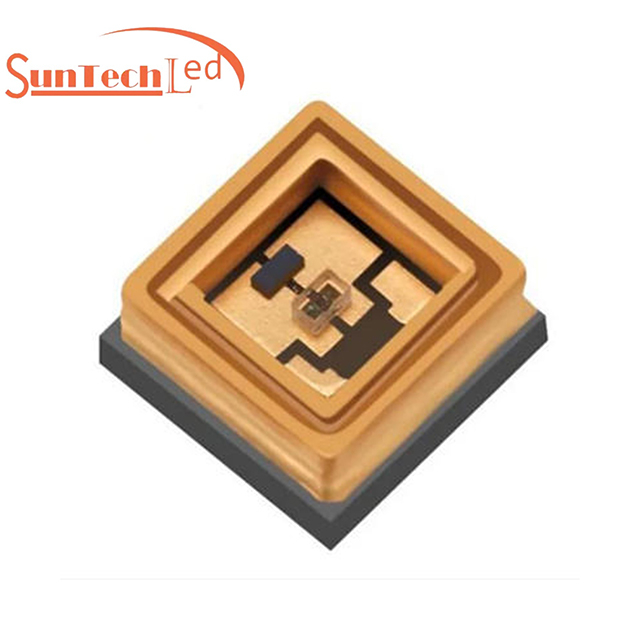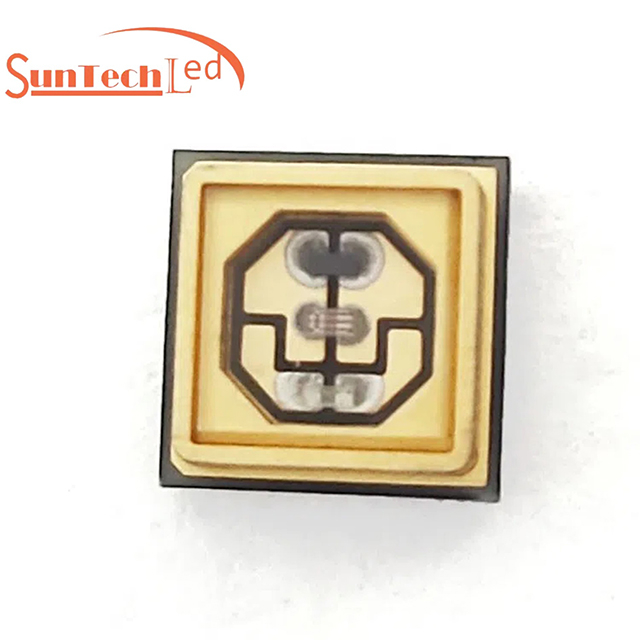English 


254nm 255nm 260nm UVC Led chip best wavelength for disinfection
| Availability: | |
|---|---|


255nm UVC LED is Recognised the best wavelength for disinfection or sterilization Application
These UVC LEDs is a revolutionary, energy efficient light source for sterilization & disinfection and medical application, with its advantages of lifetime and reliability. You can design freedom, and creating a new opportunities for solid state UVC light source to displace conventional UV technologies(Such as Mercury lamp).
The UVC LED is sealed in Ceramic packages including an optical transparent window.
It incorporates state of the art SMD design and low thermal resistance.
UVC disinfection is a physical method of disinfection. Although UVC light can't kill microorganisms directly, it can destroy the ability of microbial inactivation. Microorganisms exposure in ultraviolet radiation, the genetic material nucleic acid DNA and RNA absorb a lot of ultraviolet energy, then been destroyed and lost the ability to divide and copy, and finally natural death or the immune system to eliminate, and loss of human pathogenic ability.
Based on existing evidence, we believe so. Here's why: UVC light has been used extensively for more than 40 years in disinfecting drinking water, waste water, air, pharmaceutical products, and surfaces against a whole suite of human pathogens. All bacteria and virus tested (many hundreds over the years, including other virus) respond to UVC disinfection. Some organisms are more susceptible to UVC disinfection than others, but all tested so far do respond at the appropriate doses.
According to the International Ultraviolet Association, "the ultraviolet spectrum (the 'sterilization' region) that is important for water and air disinfection is the range absorbed by DNA (RNA in some virus). This sterilization range is about 200-300nm."
It is known that the bactericidal range extends above 280 nm, and it is now generally considered to extend to 300 nm, however this may also change with more research. Scientists have shown that ultraviolet light with a wavelength between 280nm and 300nm can be used for disinfection and sterilization.
There is a misunderstanding that 254nm is the optimal wavelength for disinfection because the peak wavelength of a low-pressure mercury lamp (determined solely by the physics of the lamp) is 253.7nm. The wavelength of 265 nm is generally considered to be optimal because this wavelength is the peak of the DNA absorption curve. However, a range of wavelengths have disinfection and sterilization effects.
4. Ultraviolet mercury lamps were once considered the best choice for disinfection and sterilization. Why is this?
Historically, mercury lamps have been the only option for disinfection and sterilization. With the advancement of UVC LED technology, there are new options because LEDs are smaller, more powerful, non-toxic, longer life, more energy efficient, and allow more switching times. This makes the solution smaller, battery-powered, more portable, and capable of instant full-light output.
5. What is the difference in wavelength characteristics between UVC LEDs and mercury lamps?
Low-pressure mercury lamps emit nearly monochromatic light with a wavelength of 253.7 nm. Low-pressure mercury lamps (fluorescent tubes) and high-pressure mercury lamps are also used for disinfection and sterilization. These lamps have a broader spectral distribution, including wavelengths used for sterilization. UVC LEDs can be focused on a narrow range of specific wavelengths, which allows the solution to be tailored to specific application needs.
6. Does the peak absorption wavelength of DNA vary by bacteria?
Yes. Different types of peak absorption wavelengths are indeed different, but most of them are around 265nm.
7. Can a single wavelength eliminate all bacteria?
Yes, a single wavelength can be used. However, bacteria have different optimal absorption wavelengths.
8. How is the bactericidal effect determined?
Generally, power intensity, wavelength, and duration of irradiation are used to determine the bactericidal effect. For example, in water, there may be multiple bacteria with different optimal absorption
wavelengths. For any given wavelength of germicidal UV, the power and time of irradiation need to be calculated to achieve the desired level of disinfection.
250nm 254nm 255nm 260nm UVC Led chip strip light best wavelength for sterilization and disinfection
9. Are UVC disinfection devices safe?
Like any disinfection system, UVC devices must be used properly to be safe. They all produce varying amounts of UVC light in wavelengths of 200nm-280nm. This UVC light is much "stronger" than normal sunlight, and can cause a severe sunburn-like reaction to your skin, and similarly, could damage the retina of your eye, if exposed. Some devices also produce ozone as part of their cycle, others produce light and heat like an arc welder, others move during their cycles. Hence, general machine-human safety needs to be considered with all disinfection devices, and these considerations should be addressed in the operations manual, in the user training, and appropriate safety compliance.
10. Are there performance standards and UVC validation protocols for UV disinfection devices?
Given the wide array of UVC devices marketed for disinfection of air, water and solid surfaces, the lack of uniform performance standards and the highly variable degree of research, development and validation testing that is performed on different devices, the IUVA urges consumers to exercise caution when selecting equipment and look for evidence of third party testing as well as certification of device materials and electrical components by well-known organizations such as UL, CSA, DVGW-OVGW or other international requirements as applicable.
For UVC devices designed to inactivate air and solid surfaces in the healthcare industry, members of IUVA are working diligently with other national standards organizations in the lighting and healthcare industry to develop disinfection testing standards[x]. The goal is to develop guidance that will help healthcare providers world-wide choose the best possible technologies for their institutions to use in the fight against multiple drug resistant organisms and other pathogens.
255nm UVC LED is Recognised the best wavelength for disinfection or sterilization Application
These UVC LEDs is a revolutionary, energy efficient light source for sterilization & disinfection and medical application, with its advantages of lifetime and reliability. You can design freedom, and creating a new opportunities for solid state UVC light source to displace conventional UV technologies(Such as Mercury lamp).
The UVC LED is sealed in Ceramic packages including an optical transparent window.
It incorporates state of the art SMD design and low thermal resistance.
UVC disinfection is a physical method of disinfection. Although UVC light can't kill microorganisms directly, it can destroy the ability of microbial inactivation. Microorganisms exposure in ultraviolet radiation, the genetic material nucleic acid DNA and RNA absorb a lot of ultraviolet energy, then been destroyed and lost the ability to divide and copy, and finally natural death or the immune system to eliminate, and loss of human pathogenic ability.
Based on existing evidence, we believe so. Here's why: UVC light has been used extensively for more than 40 years in disinfecting drinking water, waste water, air, pharmaceutical products, and surfaces against a whole suite of human pathogens. All bacteria and virus tested (many hundreds over the years, including other virus) respond to UVC disinfection. Some organisms are more susceptible to UVC disinfection than others, but all tested so far do respond at the appropriate doses.
According to the International Ultraviolet Association, "the ultraviolet spectrum (the 'sterilization' region) that is important for water and air disinfection is the range absorbed by DNA (RNA in some virus). This sterilization range is about 200-300nm."
It is known that the bactericidal range extends above 280 nm, and it is now generally considered to extend to 300 nm, however this may also change with more research. Scientists have shown that ultraviolet light with a wavelength between 280nm and 300nm can be used for disinfection and sterilization.
There is a misunderstanding that 254nm is the optimal wavelength for disinfection because the peak wavelength of a low-pressure mercury lamp (determined solely by the physics of the lamp) is 253.7nm. The wavelength of 265 nm is generally considered to be optimal because this wavelength is the peak of the DNA absorption curve. However, a range of wavelengths have disinfection and sterilization effects.
4. Ultraviolet mercury lamps were once considered the best choice for disinfection and sterilization. Why is this?
Historically, mercury lamps have been the only option for disinfection and sterilization. With the advancement of UVC LED technology, there are new options because LEDs are smaller, more powerful, non-toxic, longer life, more energy efficient, and allow more switching times. This makes the solution smaller, battery-powered, more portable, and capable of instant full-light output.
5. What is the difference in wavelength characteristics between UVC LEDs and mercury lamps?
Low-pressure mercury lamps emit nearly monochromatic light with a wavelength of 253.7 nm. Low-pressure mercury lamps (fluorescent tubes) and high-pressure mercury lamps are also used for disinfection and sterilization. These lamps have a broader spectral distribution, including wavelengths used for sterilization. UVC LEDs can be focused on a narrow range of specific wavelengths, which allows the solution to be tailored to specific application needs.
6. Does the peak absorption wavelength of DNA vary by bacteria?
Yes. Different types of peak absorption wavelengths are indeed different, but most of them are around 265nm.
7. Can a single wavelength eliminate all bacteria?
Yes, a single wavelength can be used. However, bacteria have different optimal absorption wavelengths.
8. How is the bactericidal effect determined?
Generally, power intensity, wavelength, and duration of irradiation are used to determine the bactericidal effect. For example, in water, there may be multiple bacteria with different optimal absorption
wavelengths. For any given wavelength of germicidal UV, the power and time of irradiation need to be calculated to achieve the desired level of disinfection.
250nm 254nm 255nm 260nm UVC Led chip strip light best wavelength for sterilization and disinfection
9. Are UVC disinfection devices safe?
Like any disinfection system, UVC devices must be used properly to be safe. They all produce varying amounts of UVC light in wavelengths of 200nm-280nm. This UVC light is much "stronger" than normal sunlight, and can cause a severe sunburn-like reaction to your skin, and similarly, could damage the retina of your eye, if exposed. Some devices also produce ozone as part of their cycle, others produce light and heat like an arc welder, others move during their cycles. Hence, general machine-human safety needs to be considered with all disinfection devices, and these considerations should be addressed in the operations manual, in the user training, and appropriate safety compliance.
10. Are there performance standards and UVC validation protocols for UV disinfection devices?
Given the wide array of UVC devices marketed for disinfection of air, water and solid surfaces, the lack of uniform performance standards and the highly variable degree of research, development and validation testing that is performed on different devices, the IUVA urges consumers to exercise caution when selecting equipment and look for evidence of third party testing as well as certification of device materials and electrical components by well-known organizations such as UL, CSA, DVGW-OVGW or other international requirements as applicable.
For UVC devices designed to inactivate air and solid surfaces in the healthcare industry, members of IUVA are working diligently with other national standards organizations in the lighting and healthcare industry to develop disinfection testing standards[x]. The goal is to develop guidance that will help healthcare providers world-wide choose the best possible technologies for their institutions to use in the fight against multiple drug resistant organisms and other pathogens.
